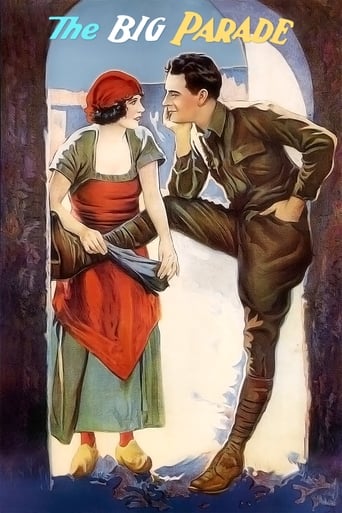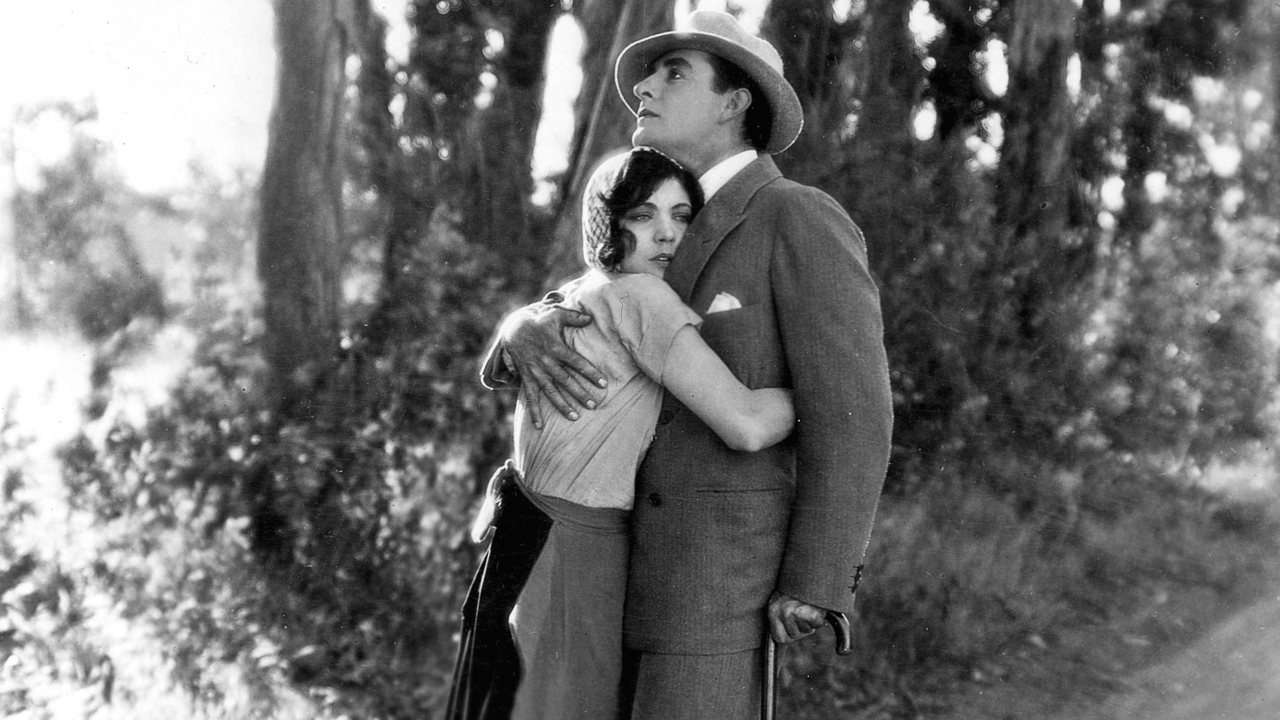kijii
This movie traces three men from the same American town. The men are from different social and economic backgrounds. Jim (John Gilbert) is the rich son of a mill owner, 'Bull' (Tom O'Brian) is a bartender, and Slim (Darl Dane) is a riveter in construction work. When America joins the Great War in Europe all three enlist. As usual in movies of this type, there is a patriotic fervor in the town at the time that they join up. Jim's girl, Justyn (Claire Adams), is one of the first to assume that Jim will enlist and make her proud. This is the first use of the term, 'The Big Parade' on the movie's title cards—the big parade of patriotic people sending boys off to war. For the first 75 minutes of the movie, we get to really KNOW these three lovable and fun-loving guys, long before they actually go into any battle situations in Europe.While in a French village waiting for a battle, Jim meets a villager, Melisande (Renee Adoree). The movie spends time with Jim and Melisande as they try to communicate with each other in two different languages and have lots of fun and laughs together. When Jim and his buddies are actually called into action, Jim promises Melisande that he will be back. The long convoys of trucks and marching soldiers advancing into battle is the second use of 'The Big Parade' on the movie's title cards.The battle scenes are very well done showing bombing, large guns, mustard gas, aerial attacks, and hand-to hand combat. Much of the time, the three soldiers are in trenches or in bomb holes. When the commander orders one of them to clean out an enemy stronghold, the question is which one will be 'IT.' Slim sets up a spitting contest to determine which of the three will go. Slim easily wins--which means that he will go. When he doesn't return, his two friends become very anxious about him. Slim dies. Bull later dies in another assault. Jim gets hurt in the leg and is sent to an army hospital in another 'Big Parade' sequence. While in the hospital, he finds out that it is near the village where he left Melisande. In a search of her, he only finds a deserted house in the bombed out village. He is again wounded and sent home. Of course, his homecoming is another 'Big Parade.' However, after the term is used several times on the movie's title cards, it becomes increasingly more hollow and sarcastic.After seeing this movie and Vidor's The Crowd (1928), I am convinced that he was one of the really great SILENT directors! His movies stress beautiful images and bustling action rather than broad acting gestures. They are both playful and sad; the are replete with a realism that conveys genuine emotion. As one watches these movies, they don't seem contrived; they seem to be about REAL PEOPLE living real lives. Vidor's magic seems to be in the WAY he captures people and events without the use of sound. At least in these two movies, he is not afraid to let the story unfold naturally. These movies seem as fresh today as they were when they were first released.
rickodonovan
Having canvassed the majority of extant films from the silent era, I have a basis of comparison in evaluating this 1925 film in which one John Gilbert proved beyond any doubt that his dramatic capabilities extended beyond matinée idol and the "Great Lover" tag that he so abhorred up until his untimely death of consumption at 36. Gilbert was leading man for none other than Greta Garbo, Lillian Gish, and Mary Pickford- a feat no other actor could boast, and indicative of the span of his career. Here he is the spoiled rich kid who volunteers for infantry and combat duty. It was a theme that Oliver Stone would draw from his own experience decades later in writing Charlie Sheen's character in Platoon. Here he is torn between a fiancée back home and an absolutely endearing French girl played with unbelievable subtlety and naturalness by Renee Adoree. Gilbert and co-stars Adoree and Karl Dane all died tragic deaths within just a few years of this outstanding film. Gilbert essentially drank himself to death, Adoree died of tuberculosis in 1933, and Dane committed suicide when the talkie era 86d his illustrious silent film career. We have them all under the careful direction of the best director of all time King Vidor. To my knowledge, over his 60+ year career in Hollywood, Vidor made not a single flop, not one film that isn't critically acclaimed. Among his arsenal- The Crowd, Show People, Ben Hur, The Jack-knife Man, La Boheme. So here I go with my bold declaration.... The Big Parade is King's finest hour. It is cleverly paced, the editing is flawless, the acting is so natural you'd think you were watching real events as they unfold. The musical score by Carl Davis is the best he has ever conjured, and that's saying an awful lot. THE BIG PARADE. Yes. Get it, turn the lights out, clear the mind, and ready yourself for the film experience of a lifetime.
Larry41OnEbay-2
THE BIG PARADE was written by Laurence Stallings, a veteran of World War I. In his autobiography, director King Vidor wrote that he was tired of laboring for months on a feature only to see it play for one week in theaters. So in 1924 he asked M-G-M's head of production, Irving Thalberg for the opportunity to make a "serious" picture that would have legs. Thalberg was convinced that good art and good box office were not necessarily incompatible and the men began to search for an appropriate war story. When Stallings' play WHAT PRICE GLORY? caught Thalberg's attention, the writer was hired.THE BIG PARADE was first designed as a modest programmer concerning one young man's disillusionment in the face of war. When the MGM executives took a look at the rushes, they gave Vidor the go-ahead to film an all-out "spectacular", which ended up running 13 reels and costing a then-astronomical $382,000. It returned 5 million dollars in the days when tickets averaged less than $.25 each.There had been war films before it but Vidor wanted to capture the human dimension behind war from a grunt's point of view. Like Vidor's other masterpiece THE CROWD it shares his philosophy that we are basically anonymous and anti-heroic our destinies determined by events out of our control.The film opens on three young men from different walks of life: a Bowery bartender, Tom O'Brien as Bull; a gawky ironworker Karl Dane as Slim; and a rich man's son, John Gilbert as James or Jimmy. Where the story differs from wartime propaganda is seen in its careful attention to each individuals humanity.The first half of the film is taken up with the horsing around between the army buddies and a young French woman they meet played by Renee Adoree. Their experiences billeting in France are at first light-hearted. There was even some controversy at the time that lip readers could make out actual curse words actors used and later versions had some shots shortened to prevent offending viewers.Gilbert woos the beautiful village girl who looks just like his fiancé back home. Scenes between Gilbert and Adoree, as he shyly flirts and she shyly retreats, made the most of Gilbert's flair for understated acting.The second half of the film gives way to the shocking reality of the horrors of war.The film's many highlights include: the gum chewing lesson (something Vidor claimed he improvised on the set to add a more human dimension); then there is the famous shot of Adoree not letting go of Gilbert as he and his fellow soldiers march to the front with the endless straight-line of hundreds of trucks suggesting the endless amount of supplies and men, the big parade if you will marching off the end of the world.Vidor prepared himself for the subject by screening documentary films made by the U. S. Army Signal Corps during World War I. When viewing footage of a group of soldiers solemnly escorting a funeral cortege, Vidor was inspired to choreograph the filming of the American forces' march through Belleau Wood to the beat of a metronome amplified by a bass drum to heighten the sense of foreboding and death.Sound was used to emotional effect during the film's remarkably successful 2 year run (a little longer than the usual one week run) at New York's Astor Theatre on Broadway, where eighteen men with bugles and wagons filled with iron created sound effects to replicate the experience of actual battle.New York Times placed The Big Parade at the top of its list of best films for 1925, praising it as "the top-notch photoplay of the year" and "unusually original in detail." The Variety review called it "the best of the war pictures" and praised John Gilbert's performance as "superb" and a "triumph for director King Vidor." War films today are usually copies of earlier films influenced by this original, I invite you to see it through those innocent eyes. As if you had never seen a war film and had just walked into a theater in 1925 . . .
wes-connors
Clean-shaven young John Gilbert (as James "Jim" Apperson) gets caught up in the patriotic fervor leading the peaceful United States into The Great War (aka World War I). In joining "The Big Parade" of enlisted men, Mr. Gilbert leaves behind his pretty sweetheart and wealthy lifestyle - and ships out for war-ravaged France. There, Gilbert bonds with two lower-class soldier buddies: spitting laborer Karl Dane (as "Slim" Jensen) and rotund bartender Tom O'Brien (as "Bull" O'Hara). Fortunately, France provides feminine distraction in the form of Renée Adorée (as Melisande). Gilbert takes Ms. Adorée for a walk, and falls in love
King Vidor's "The Big Parade" is one of the most beautifully produced and directed silent epics of the 1920s. Mr. Vidor gets the finest personnel at MGM - the studio certainly regarded, with the late 1925 release of this film and "Ben-Hur", as the best in the business. With these films, MGM had considerable evidence to back up boasting about having the Biggest Stars and the Biggest Pictures in the Business (for about two decades).The film is also a personal triumph for silent idol Gilbert, who was receiving, and handling, some of the best parts Hollywood had to offer. Gilbert shaved off his suave moustache, and really does seem like the ordinary (but wealthy) looking soldier called for by the script. Gilbert manages both the comedy and drama scenes extraordinarily well. The lengthy "comic" parts go on too long; and, this is the film's main weakness - but, the actors are not at fault. And, Gilbert's "wheel-barrel" scene is the most memorable comedy interlude. Contrastingly, the comic Dane excels in his most dramatic moment.There were no "Academy Awards" at the time - but, "The Big Parade" won "Best Picture" honors from "Photoplay", "Quigley Publications", and "The New York Times"; it was released too late in the year to overtake Chaplin's "The Gold Rush" at "Film Daily". Only Quigley offered a "Best Director" honor, which went to Vidor; in hindsight, Eisenstein's "Potemkin" would have to be considered better. And, Gilbert's "Jim" would have faced stiff "Best Actor" competition from Chaplin's "Tramp" (and Gilbert's own appearance in "The Merry Widow"). John Arnold's photography should also be noted, as well as always dependable Hobart Bosworth and Claire McDowell. Do watch "The Big Parade" until the ending. Even if you guess (or know) what will happen, it's beautifully done. This is because Vidor makes you think about Gilbert's American and French sweethearts, instead of the obvious
********* The Big Parade (11/5/25) King Vidor ~ John Gilbert, Renée Adorée, Karl Dane, Tom O'Brien


 AD
AD




